The Tissue Diagnostics Market is estimated to be valued at USD 51.8 billion in 2025 and is projected to reach USD 172.8 billion by 2035, registering a compound annual growth rate (CAGR) of 12.8% over the forecast period.
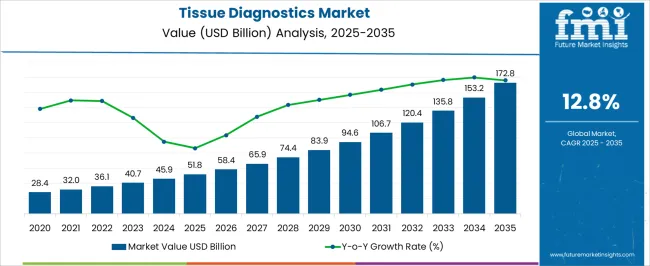
| Metric | Value |
|---|---|
| Tissue Diagnostics Market Estimated Value in (2025 E) | USD 51.8 billion |
| Tissue Diagnostics Market Forecast Value in (2035 F) | USD 172.8 billion |
| Forecast CAGR (2025 to 2035) | 12.8% |
The tissue diagnostics market is experiencing steady growth, driven by increasing demand for precise and early detection of diseases, particularly cancer. Rising awareness of the benefits of tissue-based diagnostic techniques and expanding adoption in clinical and research settings are enhancing market penetration. Technological advancements in molecular and immunohistochemistry-based assays are improving accuracy, sensitivity, and turnaround times, enabling more effective disease management.
Increasing prevalence of cancers and other chronic conditions worldwide is elevating the need for advanced diagnostic tools. Investments in healthcare infrastructure, coupled with growing focus on personalized medicine, are supporting the expansion of tissue diagnostics. Enhanced regulatory frameworks ensuring quality and reliability are further strengthening confidence among healthcare providers.
The market is also benefiting from the development of novel reagents, automated platforms, and digital pathology solutions, which streamline workflow and reduce operational inefficiencies As healthcare systems continue to prioritize early diagnosis and precision medicine, tissue diagnostics is positioned to remain an integral component of patient care, with continued growth expected across both developed and emerging markets.
The tissue diagnostics market is segmented by product, disease, application, end user, and geographic regions. By product, tissue diagnostics market is divided into Consumables, Instruments, Microscope, Non-contact Handheld IR Thermometer, Haemocytometer, NMR Tube, Others, Reagent Kits, and Others. In terms of disease, tissue diagnostics market is classified into Breast Cancer, Lung Cancer, Lymphoma, Pancreatic Cancer, and Others. Based on application, tissue diagnostics market is segmented into Immunohistochemistry (IHC), In Situ Hybridization, and Hematoxylin and Eosin (H&E). By end user, tissue diagnostics market is segmented into Hospitals, Diagnostic Laboratories, Contract Research Organizations, Research Organizations, and Biotechnology Companies. Regionally, the tissue diagnostics industry is classified into North America, Latin America, Western Europe, Eastern Europe, Balkan & Baltic Countries, Russia & Belarus, Central Asia, East Asia, South Asia & Pacific, and the Middle East & Africa.
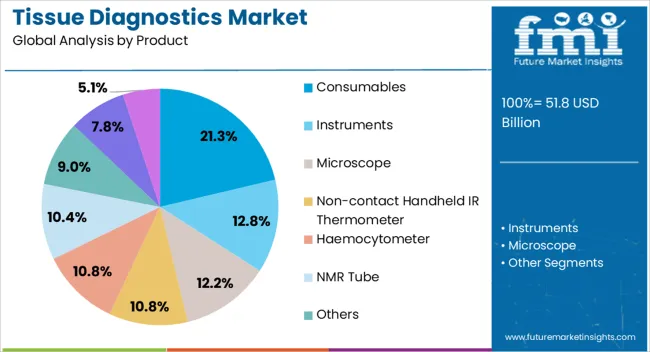
The consumables product segment is projected to hold 21.3% of the tissue diagnostics market revenue share in 2025, making it the leading product type. Its dominance is driven by the essential role consumables play in supporting laboratory workflows, including slides, reagents, stains, and assay kits. The segment benefits from recurring demand, as consumables are replaced for every new test or patient sample processed.
Increasing adoption of automated diagnostic platforms has further expanded the need for high-quality consumables that ensure consistent results and reproducibility. Manufacturers are also introducing specialized consumables compatible with advanced immunohistochemistry and molecular assays, enhancing efficiency and performance.
The segment’s growth is reinforced by expanding research and clinical testing initiatives, where consumables are critical for sample preparation and analysis As healthcare providers aim to reduce errors and improve throughput, the demand for reliable, standardized consumables continues to rise, solidifying its position as the leading product segment in the tissue diagnostics market.
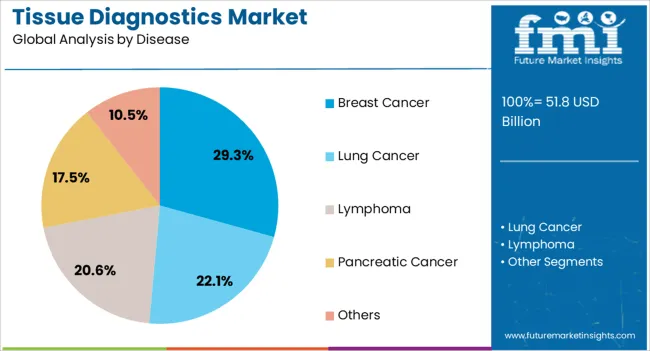
The breast cancer disease segment is anticipated to account for 29.3% of the tissue diagnostics market revenue share in 2025, establishing it as the dominant disease application area. This leadership is being reinforced by the high prevalence of breast cancer globally and the emphasis on early detection to improve patient outcomes. Advanced tissue diagnostics enable accurate identification of receptor status and molecular subtypes, which is critical for selecting targeted therapies and guiding treatment decisions.
Increasing awareness of screening programs and rising investment in oncology diagnostics are supporting the segment’s growth. Additionally, the demand for personalized medicine approaches in breast cancer management has encouraged adoption of high-sensitivity assays that can detect subtle molecular changes in tissue samples.
The integration of automated workflows and digital pathology platforms has further enhanced diagnostic accuracy and efficiency As healthcare systems continue to prioritize precision oncology, the breast cancer segment is expected to remain the primary driver of tissue diagnostics market growth, supported by continued advancements in testing methodologies and clinical adoption.
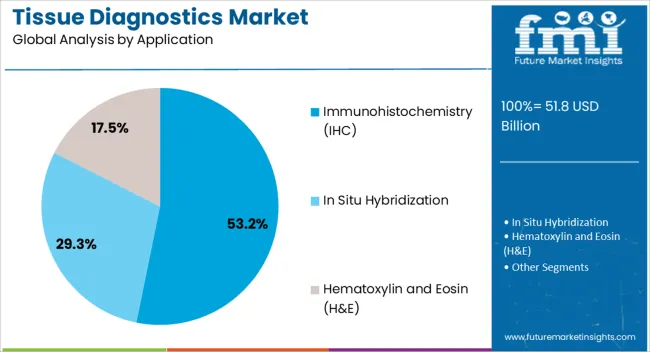
The immunohistochemistry application segment is projected to hold 53.2% of the tissue diagnostics market revenue share in 2025, making it the leading application category. Its dominance is driven by widespread use in cancer diagnosis, biomarker detection, and research applications where protein expression patterns are critical. IHC enables precise localization and quantification of antigens within tissue samples, which is essential for understanding disease progression and tailoring treatment strategies.
The segment benefits from technological advancements such as multiplex IHC, automated staining platforms, and digital image analysis, which enhance throughput, reproducibility, and accuracy. Increasing investment in oncology research and adoption of precision medicine are further stimulating demand for IHC-based assays.
Laboratories are prioritizing standardized IHC protocols to ensure regulatory compliance and improve workflow efficiency As clinical and research institutions continue to expand their diagnostic capabilities, immunohistochemistry is expected to maintain its leadership position, driven by its indispensable role in disease characterization and personalized treatment planning.
The increasing incidence and prevalence of various types of cancer, such as lung cancer and breast cancer, are expected to boost the tissue diagnostics market over the forecast period.
Additionally, innovations in devices to detect the type of cancerous tissue, a spike in technical enhancements that support the improved imaging of hazardous cells, and a rise in the precision of the outcome could help the tissue diagnostics market in achieving growth throughout the forecast period. Furthermore, increased government and private organizations’ initiatives to create awareness to identify and prevent early cancer are predicted to propel market expansion in the projected years.
Moreover, improved infrastructure of diagnostics laboratories in developed countries is expected to boost the market in the near future. Owing to the growing disposable income of the populace, the spending capability of people on health has increased. Thus, people concerned about their health are highly spending money on diagnostic treatments, even for minor symptoms. This will boost market demand.
On the basis of geographies, the global tissue diagnostics market is divided into seven major regions- North America, Latin America, Europe, East Asia, South Asia, Oceania, and the Middle East and Africa.
The tissue diagnostic market in North America is expected to maintain its hold during the forecast period followed by Europe and the Asia Pacific. Owing to the factors such as high spending on research and development activities in the biotechnology and medical equipment organizations as well as the extensive use of novel technologies, the North American region is attributed to boosting the market growth in the upcoming years.
On the other hand, Asia Pacific is anticipated to show rapid growth in the projected period. The upsurge in the medical tourism business in the nations like China and India is expected to increase the demand for diagnosis and treatment in this region. Furthermore, due to the increase in cancer cases and other disorders will further propel the market growth for tissue diagnostics.
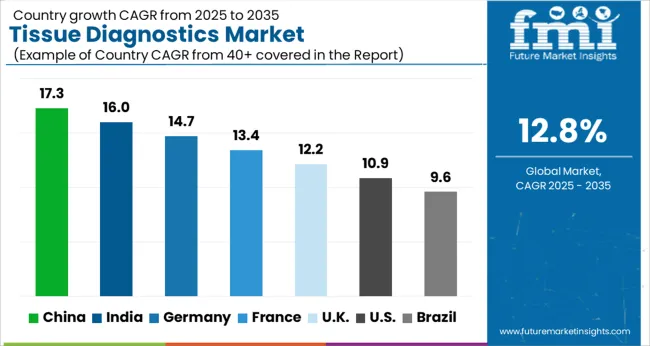
| Country | CAGR |
|---|---|
| China | 17.3% |
| India | 16.0% |
| Germany | 14.7% |
| France | 13.4% |
| UK | 12.2% |
| USA | 10.9% |
| Brazil | 9.6% |
The Tissue Diagnostics Market is expected to register a CAGR of 12.8% during the forecast period, exhibiting varied country level momentum. China leads with the highest CAGR of 17.3%, followed by India at 16.0%. Developed markets such as Germany, France, and the UK continue to expand steadily, while the USA is likely to grow at consistent rates. Brazil posts the lowest CAGR at 9.6%, yet still underscores a broadly positive trajectory for the global Tissue Diagnostics Market. In 2024, Germany held a dominant revenue in the Western Europe market and is expected to grow with a CAGR of 14.7%. The USA Tissue Diagnostics Market is estimated to be valued at USD 19.4 billion in 2025 and is anticipated to reach a valuation of USD 54.6 billion by 2035. Sales are projected to rise at a CAGR of 10.9% over the forecast period between 2025 and 2035. While Japan and South Korea markets are estimated to be valued at USD 2.7 billion and USD 1.3 billion respectively in 2025.
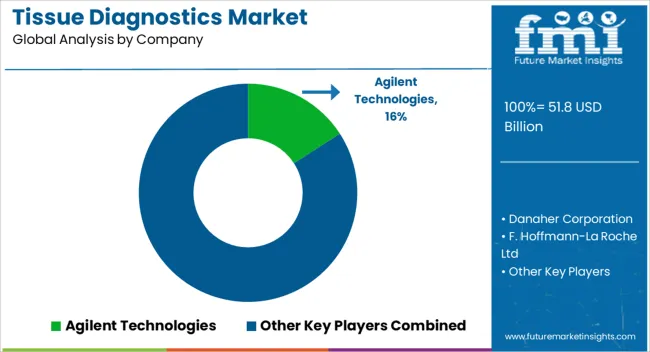
| Item | Value |
|---|---|
| Quantitative Units | USD 51.8 Billion |
| Product | Consumables, Instruments, Microscope, Non-contact Handheld IR Thermometer, Haemocytometer, NMR Tube, Others, Reagent Kits, and Others |
| Disease | Breast Cancer, Lung Cancer, Lymphoma, Pancreatic Cancer, and Others |
| Application | Immunohistochemistry (IHC), In Situ Hybridization, and Hematoxylin and Eosin (H&E) |
| End User | Hospitals, Diagnostic Laboratories, Contract Research Organizations, Research Organizations, and Biotechnology Companies |
| Regions Covered | North America, Europe, Asia-Pacific, Latin America, Middle East & Africa |
| Country Covered | United States, Canada, Germany, France, United Kingdom, China, Japan, India, Brazil, South Africa |
| Key Companies Profiled | Agilent Technologies, Danaher Corporation, F. Hoffmann-La Roche Ltd, BIOMÉRIEUX, Abbott Laboratories, Merck KGaA, General Electric Company (GE Healthcare), BioGenex, Cell Signaling Technology, Inc., and Koninklijke Philips N.V. |
The global tissue diagnostics market is estimated to be valued at USD 51.8 billion in 2025.
The market size for the tissue diagnostics market is projected to reach USD 172.8 billion by 2035.
The tissue diagnostics market is expected to grow at a 12.8% CAGR between 2025 and 2035.
The key product types in tissue diagnostics market are consumables, instruments, microscope, non-contact handheld ir thermometer, haemocytometer, nmr tube, others, reagent kits and others.
In terms of disease, breast cancer segment to command 29.3% share in the tissue diagnostics market in 2025.






Our Research Products

The "Full Research Suite" delivers actionable market intel, deep dives on markets or technologies, so clients act faster, cut risk, and unlock growth.

The Leaderboard benchmarks and ranks top vendors, classifying them as Established Leaders, Leading Challengers, or Disruptors & Challengers.

Locates where complements amplify value and substitutes erode it, forecasting net impact by horizon

We deliver granular, decision-grade intel: market sizing, 5-year forecasts, pricing, adoption, usage, revenue, and operational KPIs—plus competitor tracking, regulation, and value chains—across 60 countries broadly.

Spot the shifts before they hit your P&L. We track inflection points, adoption curves, pricing moves, and ecosystem plays to show where demand is heading, why it is changing, and what to do next across high-growth markets and disruptive tech

Real-time reads of user behavior. We track shifting priorities, perceptions of today’s and next-gen services, and provider experience, then pace how fast tech moves from trial to adoption, blending buyer, consumer, and channel inputs with social signals (#WhySwitch, #UX).

Partner with our analyst team to build a custom report designed around your business priorities. From analysing market trends to assessing competitors or crafting bespoke datasets, we tailor insights to your needs.
Supplier Intelligence
Discovery & Profiling
Capacity & Footprint
Performance & Risk
Compliance & Governance
Commercial Readiness
Who Supplies Whom
Scorecards & Shortlists
Playbooks & Docs
Category Intelligence
Definition & Scope
Demand & Use Cases
Cost Drivers
Market Structure
Supply Chain Map
Trade & Policy
Operating Norms
Deliverables
Buyer Intelligence
Account Basics
Spend & Scope
Procurement Model
Vendor Requirements
Terms & Policies
Entry Strategy
Pain Points & Triggers
Outputs
Pricing Analysis
Benchmarks
Trends
Should-Cost
Indexation
Landed Cost
Commercial Terms
Deliverables
Brand Analysis
Positioning & Value Prop
Share & Presence
Customer Evidence
Go-to-Market
Digital & Reputation
Compliance & Trust
KPIs & Gaps
Outputs
Full Research Suite comprises of:
Market outlook & trends analysis
Interviews & case studies
Strategic recommendations
Vendor profiles & capabilities analysis
5-year forecasts
8 regions and 60+ country-level data splits
Market segment data splits
12 months of continuous data updates
DELIVERED AS:
PDF EXCEL ONLINE
Tissue Engineered Skin Substitute Market Size and Share Forecast Outlook 2025 to 2035
Tissue Paper Converting Machine Market Size and Share Forecast Outlook 2025 to 2035
Tissue Extraction System Market Size and Share Forecast Outlook 2025 to 2035
Tissue-Based Genomic Profiling Market Size and Share Forecast Outlook 2025 to 2035
Tissue Paper Unwinding Machine Market Size and Share Forecast Outlook 2025 to 2035
Tissue Paper Embosser Machine Market Size and Share Forecast Outlook 2025 to 2035
Tissue and Hygiene Market Size and Share Forecast Outlook 2025 to 2035
Tissue Towel Market Analysis - Trends, Growth & Forecast 2025 to 2035
Competitive Overview of Tissue Paper Unwinding Machine Manufacturers
Market Leaders & Share in the Tissue Paper Converting Machine Industry
Tissue Paper Converting Machine Market Trends – Growth, Demand & Forecast 2025-2035
Tissue Sealants & Adhesive Market Insights - Growth & Forecast 2025 to 2035
Tissue Cultured Date Palm Market Trends – Growth & Industry Forecast 2024 to 2034
Tissue Tapes Market
Tissue and Hygiene Paper Packaging Market
Tissue Roll Unwinders Market
The Soft Tissue Repair Market is segmented by Synthetic, Allograft, Xenograft and Alloplast from 2025 to 2035
Soft Tissue Release Systems Market
Birth Tissue Products Market Analysis - Size, Share, and Forecast Outlook 2025 to 2035
Pocket Tissues Market Size and Share Forecast Outlook 2025 to 2035

Thank you!
You will receive an email from our Business Development Manager. Please be sure to check your SPAM/JUNK folder too.
Chat With
MaRIA